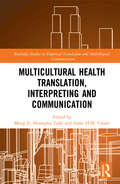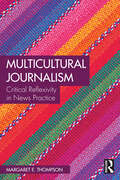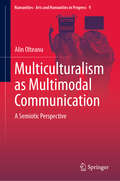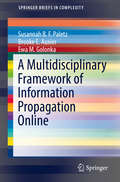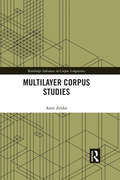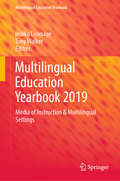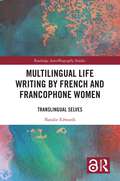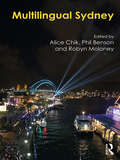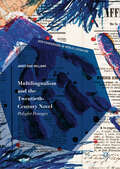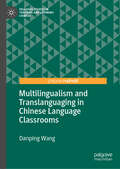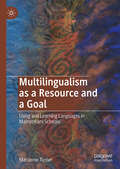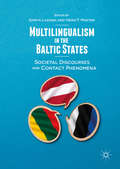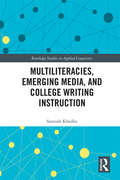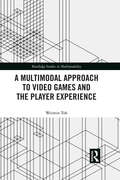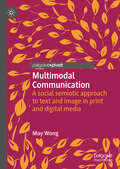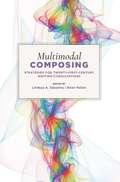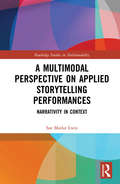- Table View
- List View
Multicultural Health Translation, Interpreting and Communication (Routledge Studies in Empirical Translation and Multilingual Communication)
by Meng Ji Mustapha Taibi Ineke H M CrezeeMulticultural Health Translation, Interpreting and Communication presents the latest research in health translation resource development and evaluation, community and professional health interpreting, and the communication of health risks to multicultural populations. Covering a variety of research topics in empirical health translation and interpreting, this advanced resource will be helpful for research students and academics of translation and interpreting studies who have an interest in health issues, particularly in multicultural and multilingual societies. This edited volume brings in interdisciplinary expertise from areas such as translation studies, community interpreting, health communication and education, nursing, medical anthropology and psychology, and will be of interest to healthcare professionals, language services in multilingual societies and researchers interested in communication between healthcare providers and users.
Multicultural Health Translation, Interpreting and Communication (Routledge Studies in Empirical Translation and Multilingual Communication)
by Meng Ji Mustapha Taibi Ineke H M CrezeeMulticultural Health Translation, Interpreting and Communication presents the latest research in health translation resource development and evaluation, community and professional health interpreting, and the communication of health risks to multicultural populations. Covering a variety of research topics in empirical health translation and interpreting, this advanced resource will be helpful for research students and academics of translation and interpreting studies who have an interest in health issues, particularly in multicultural and multilingual societies. This edited volume brings in interdisciplinary expertise from areas such as translation studies, community interpreting, health communication and education, nursing, medical anthropology and psychology, and will be of interest to healthcare professionals, language services in multilingual societies and researchers interested in communication between healthcare providers and users.
Multicultural Journalism: Critical Reflexivity in News Practice
by Margaret E. ThompsonThis book introduces a more collaborative and reflexive way of producing news that incorporates concepts of cultural identity and cultural positioning of both journalists and sources using a feminist approach to inclusion of all voices and perspectives. This text proposes a feminist collaborative model of journalism that incorporates critical reflexivity, requiring journalists not only to be aware of their own cultural positionality but also that of their sources, as a means of producing more authentic and balanced news coverage. The model is intended for use by journalists as well as journalism education programs to educate future journalists on how to effectively serve audiences with scrupulously investigated, reported, and crafted stories. Chapters explore journalism during the Obama and Trump years, current journalistic trends, and alternative media, and feature topics such as fake news, racism, sexism in news production and content, and immigration and media. Thompson addresses issues of power and privilege amongst journalists and marginalized groups, and how these implicate power dynamics of journalism practice and reinforce social inequality, particularly relating to race and gender. This book is ideal for advanced undergraduate and graduate students of journalism and media studies, as well as scholars, journalists, and media practitioners.
Multicultural Journalism: Critical Reflexivity in News Practice
by Margaret E. ThompsonThis book introduces a more collaborative and reflexive way of producing news that incorporates concepts of cultural identity and cultural positioning of both journalists and sources using a feminist approach to inclusion of all voices and perspectives. This text proposes a feminist collaborative model of journalism that incorporates critical reflexivity, requiring journalists not only to be aware of their own cultural positionality but also that of their sources, as a means of producing more authentic and balanced news coverage. The model is intended for use by journalists as well as journalism education programs to educate future journalists on how to effectively serve audiences with scrupulously investigated, reported, and crafted stories. Chapters explore journalism during the Obama and Trump years, current journalistic trends, and alternative media, and feature topics such as fake news, racism, sexism in news production and content, and immigration and media. Thompson addresses issues of power and privilege amongst journalists and marginalized groups, and how these implicate power dynamics of journalism practice and reinforce social inequality, particularly relating to race and gender. This book is ideal for advanced undergraduate and graduate students of journalism and media studies, as well as scholars, journalists, and media practitioners.
Multiculturalism as Multimodal Communication: A Semiotic Perspective (Numanities - Arts and Humanities in Progress #9)
by Alin OlteanuThis highly readable book develops a numanistic, and specifically semiotic approach to multiculturalism. It reveals how semiotics provides fresh and valuable insights into multiculturalism: in contrast to the binary logic of dualistic philosophy, semiotic logic does not understand the value of truth in rigid terms of ‘true’ or ‘false’, ‘right’ or ‘wrong’ only. The value of truth resides in meaning, which is a dynamic, evolutionary phenomenon, rooted, nevertheless, in factuality.Drawing on recent developments in biosemiotics, the book presents a theoretical approach to multiculturalism, regarding the lives of people living in multicultural environments. Rather than analyzing political or economic phenomena, it offers a semiotic analysis of multiculturalism and discusses its educational implications. It also invites readers to regard learning as a phenomenon of ecological sign growth and to understand multiculturalism along the same lines. As such, it brings together the life and social sciences and the humanities in a unified perspective, in an approach fitting postmodernism.Developing a postmodern philosophy for contemporary non-experts, which allows distancing from political discourse in favor of a posthumanistic stand, where altruism is seen as an opportunity, not a threat, this book appeals to a wide readership, from scholars seeking state-of-the-art theories to general readers looking for a thought-provoking and enlightening read.
A Multidisciplinary Framework of Information Propagation Online (SpringerBriefs in Complexity)
by Susannah B. Paletz Brooke E. Auxier Ewa M. GolonkaThis book presents a broad, multidisciplinary review of the factors that have been shown to or might influence sharing information on social media, regardless of its veracity. Drawing on literature from psychology, sociology, political science, communication, and information studies, the book provides a high-level framework of information sharing. The framework progresses through different categories. Information is first acquired or viewed from different sources; then, the target sharer has emotional and cognitive reactions to that information. The next categories involve motivations to share and the actual ability and perceptions of that ability to share. The greater context, such as culture, language, and social networks, also influences information sharing. Finally, the book distinguishes between genuine and non-genuine (inauthentic) actors. This text will appeal to students and especially to technical researchers looking for a social science perspective.
Multilayer Corpus Studies (Routledge Advances in Corpus Linguistics)
by Amir ZeldesThis volume explores the opportunities afforded by the construction and evaluation of multilayer corpora, an emerging methodology within corpus linguistics that brings about multiple independent parallel analyses of the same linguistic phenomena, and how the interplay of these concurrent analyses can help to push the field into new frontiers. The first part of the book surveys the theoretical and methodological underpinnings of multilayer corpus work, including an exploration of various technical and data collection issues. The second part builds on the groundwork of the first half to show multilayer corpora applied to different subfields of linguistic study, including information structure research, referentiality, discourse models, and functional theories of discourse analysis, synthesizing these different discussions in a detailed case study of non-standard language in its concluding chapter. Advancing the multilayer corpus linguistic research paradigm into new and different directions, this volume is an indispensable resource for graduate students and researchers in corpus linguistics, syntax, semantics, construction studies, and cognitive grammar.
Multilayer Corpus Studies (Routledge Advances in Corpus Linguistics)
by Amir ZeldesThis volume explores the opportunities afforded by the construction and evaluation of multilayer corpora, an emerging methodology within corpus linguistics that brings about multiple independent parallel analyses of the same linguistic phenomena, and how the interplay of these concurrent analyses can help to push the field into new frontiers. The first part of the book surveys the theoretical and methodological underpinnings of multilayer corpus work, including an exploration of various technical and data collection issues. The second part builds on the groundwork of the first half to show multilayer corpora applied to different subfields of linguistic study, including information structure research, referentiality, discourse models, and functional theories of discourse analysis, synthesizing these different discussions in a detailed case study of non-standard language in its concluding chapter. Advancing the multilayer corpus linguistic research paradigm into new and different directions, this volume is an indispensable resource for graduate students and researchers in corpus linguistics, syntax, semantics, construction studies, and cognitive grammar.
Multilingual Education Yearbook 2019: Media of Instruction & Multilingual Settings (Multilingual Education Yearbook)
by Indika Liyanage Tony WalkerThis book offers essential insights into the challenges and complexities surrounding the medium of instruction (MOI), its impact on all languages and stakeholders in multilingual contexts, educational processes, developments and outcomes. MOI has been a prominent topic in recent debates on the role of languages in education in multilingual contexts, partly because prioritizing one language over others as the medium of instruction has a profound impact on all languages and stakeholders in multilingual contexts. These include, to name but a few, (language) teachers, teacher educators, students, and policymakers, as well as industries and enterprises built around the needs and expectations of these stakeholders. This book presents high-quality empirical research on education in multilingual societies. It highlights research findings that, in addition to providing descriptions of language learning, development and use in language contact and multilingual contexts, will help shape future language education policy and practices in multilingual societies.
Multilingual Life Writing by French and Francophone Women: Translingual Selves (Routledge Auto/Biography Studies)
by Natalie EdwardsThis volume examines the ways in which multilingual women authors incorporate several languages into their life writing. It compares the work of six contemporary authors who write predominantly in French. It analyses the narrative strategies they develop to incorporate more than one language into their life writing: French and English, French and Creole, or French and German, for example. The book demonstrates how women writers transform languages to invent new linguistic formations and how they create new formulations of subjectivity within their self-narrative. It intervenes in current debates over global literature, national literatures and translingual and transnational writing, which constitute major areas of research in literary and cultural studies. It also contributes to debates in linguistics through its theoretical framework of translanguaging. It argues that multilingual authors create new paradigms for life writing and that they question our understanding of categories such as "French literature."
Multilingual Life Writing by French and Francophone Women: Translingual Selves (Routledge Auto/Biography Studies)
by Natalie EdwardsThis volume examines the ways in which multilingual women authors incorporate several languages into their life writing. It compares the work of six contemporary authors who write predominantly in French. It analyses the narrative strategies they develop to incorporate more than one language into their life writing: French and English, French and Creole, or French and German, for example. The book demonstrates how women writers transform languages to invent new linguistic formations and how they create new formulations of subjectivity within their self-narrative. It intervenes in current debates over global literature, national literatures and translingual and transnational writing, which constitute major areas of research in literary and cultural studies. It also contributes to debates in linguistics through its theoretical framework of translanguaging. It argues that multilingual authors create new paradigms for life writing and that they question our understanding of categories such as "French literature."
Multilingual Sydney
by Alice Chik Phil Benson Robyn MoloneyThe rise of global mobility has had a deep impact on the study of urban multilingualism. Once associated with research on minority speech communities and inner-city ethnolinguistic enclaves (Chinatowns, Little Italies, etc), it is now concerned much more with the use of multiple languages in diverse neighbourhoods across the city. In this book the authors take an innovative approach that builds on previously published work in two ways. First, it focuses on a single city and, second, it adopts a multidisciplinary approach to multilingualism. By examining the phenomenon of multilingualism in a single city from a range of perspectives this book paints a more comprehensive picture of the current dimensions of urban multilingualism. A unique feature of this book is the inclusion of contributions from scholars with expertise in education, geography, media, health communication and international studies, in addition to community practitioners. Sydney is the largest city in Australia and, on most counts, it is also among the most linguistically diverse cities in the world. As such it is an ideal site for a multidisciplinary study of urban multilingualism. The selection of 18 multidisciplinary case studies on multilingualism in Sydney, Australia represents some of the strongest and most innovative research on urban multilingualism in the world today. This book examines how multilingualism permeates institutional and everyday practice in the city, raising important questions about what a ‘multilingual city’ can and should be.
Multilingual Sydney
by Alice Chik Phil Benson Robyn MoloneyThe rise of global mobility has had a deep impact on the study of urban multilingualism. Once associated with research on minority speech communities and inner-city ethnolinguistic enclaves (Chinatowns, Little Italies, etc), it is now concerned much more with the use of multiple languages in diverse neighbourhoods across the city. In this book the authors take an innovative approach that builds on previously published work in two ways. First, it focuses on a single city and, second, it adopts a multidisciplinary approach to multilingualism. By examining the phenomenon of multilingualism in a single city from a range of perspectives this book paints a more comprehensive picture of the current dimensions of urban multilingualism. A unique feature of this book is the inclusion of contributions from scholars with expertise in education, geography, media, health communication and international studies, in addition to community practitioners. Sydney is the largest city in Australia and, on most counts, it is also among the most linguistically diverse cities in the world. As such it is an ideal site for a multidisciplinary study of urban multilingualism. The selection of 18 multidisciplinary case studies on multilingualism in Sydney, Australia represents some of the strongest and most innovative research on urban multilingualism in the world today. This book examines how multilingualism permeates institutional and everyday practice in the city, raising important questions about what a ‘multilingual city’ can and should be.
Multilingualism and the Twentieth-Century Novel: Polyglot Passages (New Comparisons in World Literature)
by James Reay WilliamsThis book argues that the Anglophone novel in the twentieth century is, in fact, always multilingual. Rooting its analysis in modern Europe and the Caribbean, it recognises that monolingualism, not multilingualism, is a historical and global rarity, and argues that this fact must inform our study of the novel, even when it remains notionally Anglophone. Drawing principally upon four authors – Joseph Conrad, Jean Rhys, Wilson Harris and Junot Díaz – this study argues that a close engagement with the novel reveals a series of ways to apprehend, depict and theorise various kinds of language diversity. In so doing, it reveals the presence of the multilingual as a powerful shaping force for the direction of the novel from 1900 to the present day which cuts across and complicates current understandings of modernist, postcolonial and global literatures.
Multilingualism and Translanguaging in Chinese Language Classrooms (Palgrave Studies in Teaching and Learning Chinese)
by Danping WangThis book presents new research on Chinese as a Second Language (CSL) teaching from an ethnographic classroom study on classroom translanguaging practices that highlights the policy and pedagogical implications of adopting a creative and principled multilingual approach. Drawing on a case study from Hong Kong, it analyses naturally observed language patterns in CSL classrooms and the attitudes of students and teachers towards prescribed classroom language policies, and thereby demonstrates the importance of mixing Chinese, English and students’ home languages to achieve successful second language learning. It discusses the nature and guiding principles for classroom translanguaging research and provides research tools that will enable second language teachers to examine their own language practices. The author argues persuasively that second language teaching practices and policies must reflect the current reality of language use and the diverse learning needs of multilingual students. This book will appeal to teacher educators and researchers in fields such as second language acquisition, foreign language teaching and language policy.
Multilingualism as a Resource and a Goal: Using and Learning Languages in Mainstream Schools
by Marianne TurnerThis book explores multilingualism as a resource and goal at school in contexts of student diversity and institutional monolingualism. Combining translanguaging theory and sociocultural theory, the author proposes a framework for the learning and use of both foreign and heritage languages across the curriculum in mainstream schools. By clearly linking language practices to teaching and learning objectives, the book aims to support school leaders and practitioners make informed decisions about how best to promote multilingualism in their school, as well as to enhance the learning outcomes of bi/multilinguals. In addition to school leaders and practitioners, it will be of interest to students and academics in the fields of bilingual education and TESOL, as well as applied linguistics and language teaching more broadly.
Multilingualism in the Baltic States: Societal Discourses and Contact Phenomena
by Sanita Lazdiņa Heiko F. MartenThis edited collection provides an overview of linguistic diversity, societal discourses and interaction between majorities and minorities in the Baltic States. It presents a wide range of methods and research paradigms including folk linguistics, discourse analysis, narrative analyses, code alternation, ethnographic observations, language learning motivation, languages in education and language acquisition. Grouped thematically, its chapters examine regional varieties and minority languages (Latgalian, Võro, urban dialects in Lithuania, Polish in Lithuania); the integration of the Russian language and its speakers; and the role of international languages like English in Baltic societies. The editors’ introductory and concluding chapters provide a comparative perspective that situates these issues within the particular history of the region and broader debates on language and nationalism at a time of both increased globalization and ethno-regionalism. This book will appeal in particular to students and scholars of multilingualism, sociolinguistics, language discourses and language policy, and provide a valuable resource for researchers focusing on Baltic States, Northern Europe and the post-Soviet world in the related fields of history, political science, sociology and anthropology.
Multiliteracies, Emerging Media, and College Writing Instruction (Routledge Research in Language and Communication)
by Santosh KhadkaThis book proposes a broad-based multiliteracies theory and praxis for college writing curriculum. Khadka expands on the work of the New London Group’s theory of multiliteracies by integrating work from related disciplinary fields such as media studies, intercultural communication, World Englishes, writing studies, and literacy studies to show how they might be brought together to aid in designing curriculum for teaching multiple literacies, including visual, digital, intercultural, and multimodal, in writing and literacy classes. Building on insights developed from qualitative analysis of data from the author’s own course, the book examines the ways in which diverse groups of students draw on existing literacy practices while also learning to cultivate the multiple literacies, including academic, rhetorical, visual, intercultural, and multimodal, needed in mediating the communication challenges of a globalized world. This approach allows for both an exploration of students’ negotiation of their cultural, linguistic, and modal differences and an examination of teaching practices in these classrooms, collectively demonstrating the challenges and opportunities afforded by a broad-based multiliteracies theory and praxis. This book will be of particular interest to scholars and researchers in writing studies, rhetoric and communication studies, multimodality, media studies, literacy studies, and language education.
Multiliteracies, Emerging Media, and College Writing Instruction (Routledge Research in Language and Communication)
by Santosh KhadkaThis book proposes a broad-based multiliteracies theory and praxis for college writing curriculum. Khadka expands on the work of the New London Group’s theory of multiliteracies by integrating work from related disciplinary fields such as media studies, intercultural communication, World Englishes, writing studies, and literacy studies to show how they might be brought together to aid in designing curriculum for teaching multiple literacies, including visual, digital, intercultural, and multimodal, in writing and literacy classes. Building on insights developed from qualitative analysis of data from the author’s own course, the book examines the ways in which diverse groups of students draw on existing literacy practices while also learning to cultivate the multiple literacies, including academic, rhetorical, visual, intercultural, and multimodal, needed in mediating the communication challenges of a globalized world. This approach allows for both an exploration of students’ negotiation of their cultural, linguistic, and modal differences and an examination of teaching practices in these classrooms, collectively demonstrating the challenges and opportunities afforded by a broad-based multiliteracies theory and praxis. This book will be of particular interest to scholars and researchers in writing studies, rhetoric and communication studies, multimodality, media studies, literacy studies, and language education.
A Multimodal Approach to Video Games and the Player Experience (Routledge Studies in Multimodality)
by Weimin TohThis volume puts forth an original theoretical framework, the ludonarrative model, for studying video games which foregrounds the empirical study of the player experience. The book provides a comprehensive introduction to and description of the model, which draws on theoretical frameworks from multimodal discourse analysis, game studies, and social semiotics, and its development out of participant observation and qualitative interviews from the empirical study of a group of players. The volume then applies this approach to shed light on how players’ experiences in a game influence how they understand and make use of game components in order to progress its narrative. The book concludes with a frame by frame analysis of a popular game to demonstrate the model’s principles in action and its subsequent broader applicability to analyzing video game interaction and design. Offering a new way forward for video game research, this volume is key reading for students and scholars in multimodality, discourse analysis, game studies, interactive storytelling, and new media.
A Multimodal Approach to Video Games and the Player Experience (Routledge Studies in Multimodality)
by Weimin TohThis volume puts forth an original theoretical framework, the ludonarrative model, for studying video games which foregrounds the empirical study of the player experience. The book provides a comprehensive introduction to and description of the model, which draws on theoretical frameworks from multimodal discourse analysis, game studies, and social semiotics, and its development out of participant observation and qualitative interviews from the empirical study of a group of players. The volume then applies this approach to shed light on how players’ experiences in a game influence how they understand and make use of game components in order to progress its narrative. The book concludes with a frame by frame analysis of a popular game to demonstrate the model’s principles in action and its subsequent broader applicability to analyzing video game interaction and design. Offering a new way forward for video game research, this volume is key reading for students and scholars in multimodality, discourse analysis, game studies, interactive storytelling, and new media.
Multimodal Communication: A social semiotic approach to text and image in print and digital media
by May WongThis book draws on visual data, ranging from advertisements to postage stamps to digital personal photography, to offer a complex interpretation of the different social functions realised by these texts as semiotic artefacts. Framed within the media environment of the city of Hong Kong, the study demonstrates the importance of social context to meaning making and social semiotic multimodal analysis. This book will be of interest to readers in the arts, humanities and social sciences, particularly within the fields of semiotics, visual studies, design studies, media and cultural studies, anthropology and sociology.
Multimodal Composing: Strategies for Twenty-First-Century Writing Consultations
by Patrick Anderson Shawn Apostel Jarrod Barben Brandy Bell Blake Sarah Blazer Brenta Blevins Russell Carpenter Florence Davies Kate Flom Derrick Lauri Dietz Clint Gardner Karen Head Alyse Knorr Jarret Krone Sohui Lee Joe McCormick Courtnie Morin Alice Johnston Myatt Molly Schoen James C. W. TrumanMultimodal Composing provides strategies for writing center directors and consultants working with writers whose texts are visual, technological, creative, and performative—texts they may be unaccustomed to reading, producing, or tutoring. This book is a focused conversation on how rhetorical, design, and multimodal principles inform consultation strategies, especially when working with genres that are less familiar or traditional. Multimodal Composing explores the relationship between rhetorical choices, design thinking, accessibility, and technological awareness in the writing center. Each chapter deepens consultants’ understanding of multimodal composing by introducing them to important features and practices in a variety of multimodal texts. The chapters’ activities provide consultants with an experience that familiarizes them with design thinking and multimodal projects, and a companion website (www.multimodalwritingcenter.org) offers access to additional resources that are difficult to reproduce in print (and includes updated links to resources and tools). Multimodal projects are becoming the norm across disciplines, and writers expect consultants to have a working knowledge of how to answer their questions. Multimodal Composing introduces consultants to key elements in design, technology, audio, and visual media and explains how these elements relate to the rhetorical and expressive nature of written, visual, and spoken communication. Peer, graduate student, professional tutors and writing center directors will benefit from the activities and strategies presented in this guide. Contributors: Patrick Anderson, Shawn Apostel, Jarrod Barben, Brandy Ball Blake, Sarah Blazer, Brenta Blevins, Russell Carpenter, Florence Davies, Kate Flom Derrick, Lauri Dietz, Clint Gardner, Karen J. Head, Alyse Knorr, Jarret Krone, Sohui Lee, Joe McCormick, Courtnie Morin, Alice Johnston Myatt, Molly Schoen, James C. W. Truman
A Multimodal Perspective on Applied Storytelling Performances: Narrativity in Context (Routledge Studies in Multimodality)
by Soe Marlar LwinIn this volume, Soe Marlar Lwin proposes a contextualized multimodal framework that brings together storytelling practitioners’ and academic researchers’ conceptions of storytelling. It aims to highlight the ways in which various institutions in contemporary society have been using live storytelling performances as an effective communicative, educative and meaning-making tool. Drawing on theories of narrative from narratology as well as from related fields such as discourse analysis, multimodal analysis, communication and performance studies, the author proposes a contextualized multimodal framework to (a) uncover the potential narrativity of a live storytelling performance through an analysis of narrative elements constituting the story, (b) capture the process of developing actual narrativity through a multimodal analysis of performance features in the storytelling discourse, and (c) highlight the importance of context and dynamics between the storyteller and audience for an achievement of optimal narrativity in a particular storytelling event. The sample analysis shows how the framework not only describes the system governing institutionalized storytelling performances in general but also serves as a useful model to examine individual performance as a unique realization of the general system. The book also offers implications for possible applications of such contextualized multimodal frameworks more broadly across the disciplines.
A Multimodal Perspective on Applied Storytelling Performances: Narrativity in Context (Routledge Studies in Multimodality)
by Soe Marlar LwinIn this volume, Soe Marlar Lwin proposes a contextualized multimodal framework that brings together storytelling practitioners’ and academic researchers’ conceptions of storytelling. It aims to highlight the ways in which various institutions in contemporary society have been using live storytelling performances as an effective communicative, educative and meaning-making tool. Drawing on theories of narrative from narratology as well as from related fields such as discourse analysis, multimodal analysis, communication and performance studies, the author proposes a contextualized multimodal framework to (a) uncover the potential narrativity of a live storytelling performance through an analysis of narrative elements constituting the story, (b) capture the process of developing actual narrativity through a multimodal analysis of performance features in the storytelling discourse, and (c) highlight the importance of context and dynamics between the storyteller and audience for an achievement of optimal narrativity in a particular storytelling event. The sample analysis shows how the framework not only describes the system governing institutionalized storytelling performances in general but also serves as a useful model to examine individual performance as a unique realization of the general system. The book also offers implications for possible applications of such contextualized multimodal frameworks more broadly across the disciplines.
